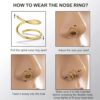Nose Piercing
How to Cover Nose Piercing for Swimming
Are you a swimming lover with a new nose piercing?
Do you worry about how to keep it safe in the water?
You’re not alone. The risk of infection and damage to fresh piercings while swimming can be scary. But don’t worry, I’ve got a solution for you.
As a professional piercer and an avid swimmer, I’ve been through this. My experiences led me to create this guide on “How to Cover a Nose Piercing for Swimming”.
This guide will help you understand why it’s crucial to protect your piercing and how to do it right. We’ll cover the risks and the step-by-step process.
You can trust me on this. So, let’s dive into this guide and solve this issue once and for all!
In a rush? Here’s our quick answer:
To cover your nose piercing for swimming, start by cleaning the area around your piercing with a saline solution. Next, choose a protection method such as a waterproof plaster, a nose piercing retainer, or a specialty piercing protector. If you’re using a plaster or protector, stick it securely over your piercing, ensuring all edges are sealed. If using a retainer, replace your current jewelry with the retainer. After swimming, clean the area again with saline solution. If you used a retainer, you might want to switch back to your original jewelry after everything is dry. Remember, it’s best to wait until your piercing is fully healed before swimming. If you must swim, always follow these steps to protect your piercing.
Contents
Key Takeaways
- It’s crucial to protect a fresh nose piercing while swimming to prevent potential infections caused by bacteria in the water.
- You can safeguard your piercing by using waterproof plasters, nose piercing retainers, or specialty products designed to shield piercings during swimming.
- Before swimming, prepare your piercing by cleaning the area with a saline solution.
- After swimming, perform a thorough clean again to remove any bacteria that may have breached the cover.
- If you’re swimming regularly, consider using a nose-piercing retainer. It’s discreet and designed to maintain the piercing hole while you swim.
- No matter how well you cover it, minimize the time your piercing is submerged in water, and where possible, avoid submerging your head.
- Always wait until your piercing has fully healed before swimming. If this isn’t possible, the steps above can help protect your piercing.
Understanding the Importance of Covering Your Nose Piercing
Risks Associated with Swimming with a Fresh Piercing
You might be asking, why is it necessary to cover a nose piercing for swimming? Well, the issue lies in the water. Bodies of water, especially public swimming pools and open water bodies, are breeding grounds for bacteria and other microorganisms. These can potentially cause infections in a new piercing.
Benefits of Covering Your Piercing
Covering your piercing can save you from unwanted complications like infections, piercing rejection, or prolonged healing time. The cover acts as a barrier between the water and your fresh wound, keeping it dry and safe.

Various Methods to Cover Your Nose Piercing
Waterproof Plasters
Waterproof plasters are a simple and readily available solution. They’re easy to apply, and their transparent nature makes them relatively discreet. However, ensure they are latex-free if you have a latex allergy.
Nose Piercing Retainers
Made of clear or skin-toned plastic or glass, nose-piercing retainers are a great option if you’re planning to swim regularly. They’re designed to maintain the piercing hole and are barely noticeable.
Specialty Products
Certain companies produce products specifically designed to protect piercings during activities like swimming. These include waterproof piercing protectors and shields.
Step-by-step Guide to Covering Your Nose Piercing for Swimming
Preparing Your Piercing
Start by cleaning the area around your piercing with a saline solution. This reduces the risk of introducing any bacteria into the piercing when applying the cover.
Applying the Cover
If you’re using a plaster or a shield, stick it over your piercing, making sure all edges are sealed. If you’re using a retainer, carefully remove your current jewelry and replace it with the retainer.
Aftercare Post-Swimming
After swimming, clean the area again with saline solution. If you used a retainer, you might want to switch back to your original jewelry after ensuring everything is dry.
Expert Tips for Swimming with a Nose Piercing
Let’s swim over to some expert tips that will help keep your nose piercing safe while you enjoy your time in the water.
Wait It Out:
It’s smart to wait until your piercing is fully healed before hitting the water. This typically takes 2-4 months.
Cover It Up:
Always use a cover, like waterproof plasters, retainers, or specialty protectors to keep your piercing safe while swimming.
Clean Carefully:
Before and after swimming, make sure to clean the piercing area with saline solution to ward off any potential infections.
Minimize Water Time:
Try to reduce the time your piercing is submerged in water. The less exposure to water, the lower the risk of infection.
Consider the Type of Water:
Sea and pool water contains different bacteria. If possible, avoid swimming in overly chlorinated pools or very salty sea water as these can irritate your piercing.
Avoid Touching:
Resist the urge to touch your piercing while swimming. Your hands might carry bacteria that can cause infection.
Post-Swim Care:
After swimming, remove the cover, clean the area thoroughly, and dry it before putting the jewelry back in.
Further Reading for Piercing Enthusiasts:
- How to Take Out a Labret Nose Stud
- 18g vs 20g Nose Rings: Which One is Right for You?
- How to Put in a Nose Ring with a Hook
- How to Take Out Nose Stud with Flat Back
- How to Put in a Double Hoop Nose Ring
- How To Reopen A Closed Nose Piercing
- Nasallang Piercing
- High Nostril Piercing
- Foods To Avoid After Nose Piercing
- What Gauge Is A Nose Piercing
- Is Titanium Good For Nose Piercings
FAQs
Can I swim if I just got my nose pierced?
It’s recommended to avoid swimming immediately after getting a nose piercing as the wound is fresh and more prone to infections. If swimming is unavoidable, always use a waterproof cover for the piercing and clean thoroughly afterward.
How do you hide a nose piercing with a bandage?
A clear or skin-toned waterproof bandage can be used to hide a nose piercing. Clean the piercing area, then carefully place the bandage over the piercing, ensuring it’s sealed on all sides. Remember, it should be a latex-free bandage if you have a latex allergy.
Do waterproof bandages work for piercings?
Yes, waterproof bandages are an effective way to protect piercings while swimming. They create a barrier between the piercing and the water, helping prevent exposure to bacteria and other potential irritants.
What tape can I use to cover a piercing for swimming?
A waterproof, hypoallergenic tape is the best option for covering a piercing for swimming. The tape should be applied to clean, dry skin, ensuring it completely covers the piercing for optimal protection.
Can I put a bandaid over my nose piercing?
Yes, you can put a bandaid over your nose piercing, but it must be waterproof to ensure effective protection while swimming. Clean the piercing first, then apply the bandaid, making sure all sides are securely adhered to your skin. After swimming, remove the bandaid and clean the piercing again with saline solution.
How soon can I swim after getting a nose piercing?
It’s best to wait until your piercing is fully healed, which typically takes 2-4 months. If you must swim, always cover your piercing and clean it thoroughly afterward.
Can I use regular plasters to cover my nose piercing?
Regular plasters aren’t waterproof and won’t provide sufficient protection. It’s best to use a waterproof plaster or other dedicated products.
How often should I clean my piercing after swimming?
Clean your piercing immediately after swimming and then continue with your regular cleaning routine.
Can I swim in the sea with a new piercing?
Sea water contains salt which can be healing, but it also harbors bacteria. If you must swim in the sea, it’s crucial to clean your piercing immediately afterward.
Conclusion
Covering your nose piercing for swimming doesn’t have to be a hassle. With a little bit of planning and the right products, you can enjoy swimming without risking the health of your piercing.
Before you go, make sure to delve into our meticulously detailed guide on double nose piercing – an essential read for anyone considering this unique form of expression.

Camila Luna is a passionate jewelry enthusiast and content creator at Miami Jewelry Co. With a focus on providing high-quality, Miami-style jewelry, Camila and her team specialize in a wide range of jewelry that includes bracelets, necklaces, earrings, and more











